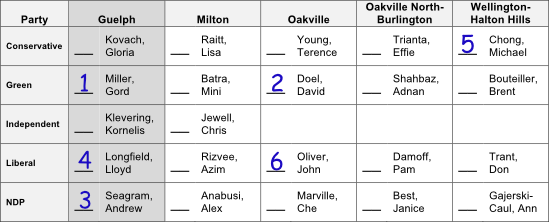How Local PR Works
Local PR groups 4-71 ridings into a region. Voters within the region rank candidates on a ballot similar to the following. The voter’s own riding is highlighted. A voter can rank as few (just 1!) or as many candidates as they want.

Counting is like many leadership races: the ballots are placed in piles according to the first preference vote (this one goes on the pile for Gord Miller). The candidate with the smallest pile is suspended and those ballots redistributed to the next prefered candidate. Eventually a candidate will have enough votes to win a seat. That person is declared a winner and all the other candidates in that riding are removed from the election. This describes one “round” of an LPR election. There are as many rounds as their are ridings in the region.
Each of the remaining rounds is restarted with the all of the original candidates except those in ridings where someone has already won a seat. Votes cast for them are redistributed to their next preference. Candidates are then suspended and their votes transferred until a new (not previously elected candidate) is elected. These rounds proceed until all the seats are filled.
This procedure maximizes the value of every ballot while keeping every candidate in the running as long as possible.
The Details section describes the process in more depth.
- LPR works with groups of 4-7 or even more ridings, however we think the ideal target range is 5-6 ridings to balance proportionality with overall size. [return]